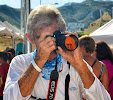The total cost of Hania’s device and surgery will be approximately $30,000 USD; to date more than 60% of the $30,000 or $18,000 has been raised.
When Hania Lopez Sosa was barely eight months old, her mother realized that her treasured baby girl was not hearing or reacting to sounds when she tried to play with her.
A local doctor recommended that the infant be taken to an ear specialist for tests, the results of which confirmed the upsetting news that Hania had a severe hearing defect. Further tests revealed that despite being equipped with the most sophisticated hearing aids available, the precocious seven year old would not be able to live a normal life. Hania, who lives with her parents in San José del Cabo BCS, is unable to hear or speak.
The hearing specialists prescribed an alternative for Hania. A cochlear implant is a surgically implanted electronic device that provides a sense of sound to a profoundly deaf individual. Unfortunately, the device and surgery required is very expensive and well beyond the family's resources. According to the doctors, timing is critical and the younger Hania is when the electronic device is implanted, the better, in order to facilitate her ability to speak.
Oscar Daccarett, Sport Fishing Commissioner, Baja California Sur, moved by Hania's touching story, directed Clicerio Mercado, Coordinator for Circuito Copa Gobernador Tournament series, to organize a last-minute benefit tournament to be held in Cabo San Lucas to raise funds to help with her surgery.
Circuito Copa Gobernador Tournaments were founded by Baja Sur’s Gobernador Narciso Agúndez Montaño and Sr. Daccarett in August, 2006 to introduce sportfishing not only the adults in the many small communities that dot the coastline of the state Baja, but to the children as well. During the past four years, sixty-three tournaments have been held in small communities throughout the state with more than 26,900 anglers participating in offshore, inshore and beach fishing.
Clicerio Mercado, Tournaments Coordinator, using the expertise and resources developed for these events, turned the attention to the plight of Hania Lopez Sosa and her need for the expensive surgery which could alter her life. The result was the Tornero de Pesca which would both increase the awareness and raise additional funds to implant the cochlear device and to provide the medical care necessary, as well as the on-going therapy needed to improve her speech.
The event began with registration at the Wamongo Restaurant on the Marina Boardwalk on the afternoon on the 10th of December. The following morning the tournament began with the traditional flare gun start at 8:00 a.m. Ten teams with forty anglers participating sped off in different directions in search of the winning fish. Fortunately, the fishing was good and the weigh-station which opened at 2 p.m. was busy until the official closing at 4 p.m.
Solomon’s Landing and Baja Cantina hosted the awards banquet and like the old days twenty-two years ago, cash awards were given for the largest yellowfin tuna and wahoo. The winners were:
TUNA
TUNA
1st place, Larry Loschuk, 41.6 Lb $20,000 Pesos
2nd place Carlos Jimenez Partida, 41.2 Lb $15,000 Pesos
3th place Victor Saiza, 23.4 LB $10,000 Pesos
Tuna Jackpot $2,000 Pesos was won by second place Carlos Jimenez
Wahoo
Wahoo
1st place Chris Fuller, 11.2 Lb $20,000
Each of the winning teams volunteered 25% of their winnings to Hania's fund, amounting to over $1,500 which was generously matched by the Bisbee’s Tournament organization.
Sra. Dolores Concepcion Zenteno y Sr. Francisco Talamantes Mendoza, grandparents of Hania were on hand and thanked the organizers and participants for their interest and generous contributions.
Clicerio Mercado also suggested that anyone wishing to contribute to the fund may do so by mailing a check to:
Dolores Concepcion Zenteno
Dolores Concepcion Zenteno
Restaurant Wamongo
Boulevard Marina
Boulevard Marina
Tesoro Los Cabos Hotel, C-6
Cabo San Lucas, B.C.S
The total cost of Hania’s device and surgery will be approximately $30,000 USD; to date more than 60% of the $30,000 or $18,000 has been raised.
What could be better this Christmas Season than giving the gift of noise to Hania? Allowing her to enjoy the best Christmas of her young life… instead of the world of silence that greeted her at birth, the anticipation of a lifetime of noise.



